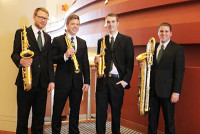by Jeremy Reynolds

“This is our first year playing in ChamberFest,” said Tracy. “We were contacted by Diana Cohen about four months ago, asking if we wanted to be a part of the festival. We knew Diana and Frank Cohen by reputation, and we knew that this was a festival of the highest professional caliber. It’s one of the best kind of festivals we could hope to be invited to, and we feel very lucky to be involved with people as talented and successful as they are.”
Why Tread on the Trail at a concert celebrating American music? “This is a piece that Diana suggested based on its jazz connotations,” said Tracy. “The piece is for an unspecified number of unspecified instruments. It’s been done with mixed chamber groups, and I’ve heard recordings of with up to sixty people. We’re doing it as soprano, alto, tenor, and baritone quartet.”
Riley’s musical notation can be a bit strange sometimes. “The score is on one sheet of music, and everybody reads off of the same sheet,” said Tracy. “There are four or five lines of music to be repeated at the performers’ discretion. We the performers have to be in communication with one another and know where we all are to help this piece make some kind of logical sense. But it should work with anybody playing any of the parts at any time.”
Does the piece use functional harmony? “No, it’s minimalist,” said Tracy. “The music is designed to line up metrically, though. If I’m playing line one and the alto player is playing line three, as long as we start at the same time the music will line up and sound the way Riley meant it to.”
Tread on the Trail is of unspecified length. How will the quartet decide how long the piece should last? “I’ve heard it last as little as eight and up to about thirty minutes long, and our performance will be about ten to twelve minutes long,” said Tracy. “It’s something we will be talking about during rehearsals. Going out there without a plan is the best way to find yourself in trouble with a piece like this. It’s certainly not music you can wing — it takes a lot of work.”
The instrumentation is also at the performers’ discretion. How does it sound for saxophone quartet? “It works very well for the quartet!” said Tracy. “The music that Riley has written is heavily jazz-influenced, and the saxophone is particularly well-suited for that type of music. The piece is dedicated to Sonny Rollins, though I’m not sure if he ever played it.”
What’s the greatest difficulty in putting something like this together? “One of the hardest things for us is that the music is written in concert pitch, and we all have to transpose differently,” Tracy said. “As a soprano player, I have to transpose the music up a ninth, which is the biggest challenge so far. But it’s going well and we’re looking forward to performing it.”
How long has the quartet been together? “Three of the members have been playing together for three years now, and two years ago we did a bit of shuffling around,” said Tracy. “The current group has played together for two years now. All of us studied at Michigan State, and all of us were doctoral students, but I just graduated with my DMA this year. So I’m not a student anymore, but the other three are still there. We had to replace one member of the quartet for this gig, but we’ve known the replacement (Jeff Kinsey, alto) for two years, and he’s a first-rate player.”
Will the ensemble stay together post-graduation? “It depends on where we all end up,” Tracy said. “It’s up in the air whether we’ll be in the same place or not. Regardless, our goal is to keep developing our repertoire and to keep performing at chamber music festivals and saxophone conferences to get more exposure. We’re hoping that by putting together an excellent performance for ChamberFest, coors will be opened and we might be invited back sometime.”
Published on ClevelandClassical.com June 24, 2015.
Click 062315-CF-TracyPrev for a printable copy of this article



